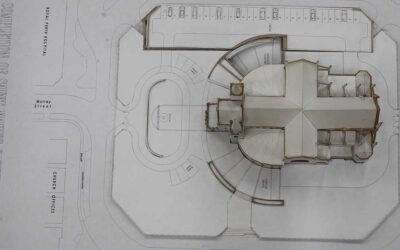Remembering History, Moving Forward Together, with ArchivEra
The Catholic Diocese of Arlington’s Director of Archives selected ArchivEra to manage their collections of historical and cultural significance, and strike a balance between security and access.
The Diocese was established 50 years ago, but their archives contains parish records from the mid-1800s. Currently, 75% of the materials are documents, and 25% consists of photographs, art works, and audiovisual materials. The archives is a small-to-medium sized repository, with one full time archivist and one part-time person working on their collection.
When Director of Archives Lindsay Alukonis came into her role, getting a CMS in place was an exciting step forward. With the cataloging backlog under control, moving forward the collection will be 90% digital—both born-digital and digitized, with digitization focused on photographs, books, and journals.
In time, there will be an ArchivEra public portal to the archival collections. As the Diocese celebrates its 50th anniversary, it is focused on three pillars—one of which is “History and Remembering”. It was a strategic goal to get the CMS set up and established in order to connect people to the first 50 years and they are well on their way—with confidence in ArchivEra’s robust permissions and security capabilities.
ArchivEra meets the archives’ needs surrounding organization and access to past archival content, and anticipates the possibilities for managing future content. Says Ms. Alukonis, “As we move forward, we know it can move forward with us.”
We invite you to read their full success story here.
Never miss another post. Subscribe today!
Similar Posts
Cultivating a Community of Archival Practice: A Client’s Success Story
“We need a dynamic system that supports a consistent approach to managing the Perth diocesan collections across Western Australia…ArchivEra is already providing this with Catholic dioceses in Bendigo, Hobart, and Ballarat.”
Honoring Cultural Protocols in Archival Practice
Learn how archives can honor Indigenous cultural protocols, reframe stewardship, and move toward ethical, reciprocal, and community-driven practices.
Centering Sovereignty in Archives: Decolonial Approaches to Indigenous Knowledge
Margot Note explores how centering sovereignty in archives supports Indigenous rights, decolonial practice, justice, and cultural resurgence.
The Ethical Use of Born-Digital Materials in Archives
Born-digital records introduce complex ethical dilemmas involving consent, privacy, preservation, and access. Archivists must rethink ethical frameworks to navigate digital records’ dynamic, fragmented, and often personal nature.





Leave a Comment
Comments are reviewed and must adhere to our comments policy.
0 Comments